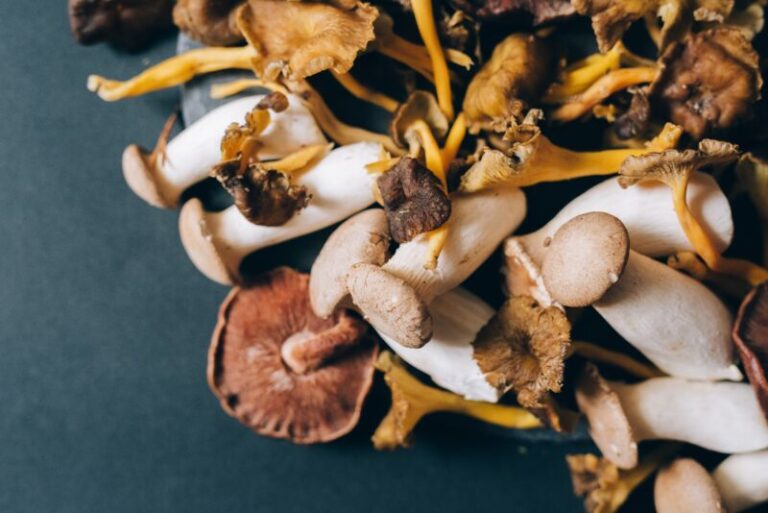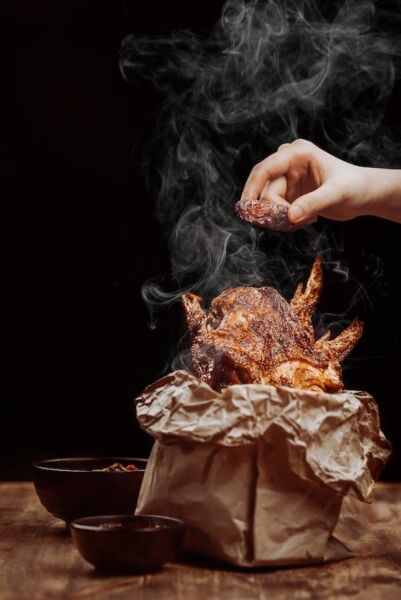Should You Boil Potatoes With The Skins On Or Peel Them First?
Cooking potatoes is a kitchen skill that most home cooks master early on. However, there’s an age-old question that still gets debated: should you boil potatoes with the skins on or peel them first?
Both approaches have their merits, so let’s dig into the pros and cons of boiling potatoes whole or peeling them beforehand.
When To Leave Potato Skins On During Boiling
Leaving the potato skins on has some nutritional and culinary benefits. Here’s when it makes sense to boil potatoes whole.
Nutrient And Flavor Preservation
The skin of a potato contains a number of vitamins, minerals and phytochemicals.
According to the United States Department of Agriculture (USDA), the potato skin alone contains 16% of the Daily Value (DV) for vitamin C, 15% DV for vitamin B6, 12% DV for potassium, and 11% DV for magnesium in just one medium potato skin.
Leaving the skins on preserves these nutrients. The skin also seals in some of the potato’s natural moisture and flavors.
If you peel potatoes before boiling them, some of the moisture and soluble nutrients leach out into the cooking water.
Ideal For Starchy Potatoes
Starchier potatoes tend to benefit more from leaving the skins on when boiling. The thicker skin helps maintain the potato’s structure and prevents it from breaking down too much in the water.
Some examples of starchier potatoes that are great for boiling whole include:
- Russet – The classic baking potato, known for its brown, netted skin and fluffy texture when baked. Russets hold their shape well when boiled whole.
- Jewel Yam – A sweet, orange-fleshed potato with purple skin. The skin adds visual appeal and keeps this tender potato intact.
- Gold Rush – This golden-skinned, white-fleshed heirloom potato has a creamy texture. The skin helps retain moisture.
Works For All-Purpose Potatoes Too
While starchy potatoes gain the most from skin-on boiling, many all-purpose potatoes can go either way. Their moderately thick skin won’t hinder the boiling process too much.
Some versatile potatoes you can boil with or without the skin:
- Yukon Gold – A popular all-purpose potato with thin, yellow skin. It holds its shape decently with skins on.
- All Blue – A striking blue-fleshed potato with purple skin. The color remains whether boiled whole or peeled.
- Red Gold – A red-skinned, creamy white potato that can boil well either way.
- Purple Majesty – This purple potato has moist, dense flesh that doesn’t fall apart too easily when boiled whole.
When To Peel Potatoes Before Boiling

While potato skins provide some benefits, there are times when peeling before boiling can be preferable.
Saves Time
Peeling potatoes by hand takes time. Removing the skins beforehand streamlines the cooking process.
If you’re making a large batch of potatoes for a family meal or gathering, peeling them first can save on labor. You can focus on other cooking tasks while the peeled potatoes boil.
Better For Certain Dishes
Potatoes boiled whole with the skins on won’t work for all recipes. Some dishes require peeled, diced potatoes instead.
Potato soups, stews and chowders tend to use peeled, cubed potatoes for the right consistency. The skins could make the texture too uneven.
Potato salad also requires peeled potatoes. Leaving the skin on would give the salad an unpleasant mouthfeel.
Ideal For Waxy Potatoes
Waxy potatoes have thin, smooth skins that are easy to peel. Leaving the skin on can hinder the cooking process.
Waxy varieties also have lower starch content. The skin isn’t needed to maintain structure when boiling.
Some waxy potatoes that are best for peeling before boiling include:
- New potatoes – These young, small potatoes have paper-thin skin. It’s easiest to peel them.
- Red Bliss – A classic red-skinned potato with moist, dense flesh. Easy to peel when small.
- Baby potatoes – Tiny creamer potatoes with thin skin. Quick to peel using a paring knife.
- French Fingerling – A slender, finger-shaped potato. The thin skin can be rubbed off if desired.
- Red Adirondack – This vibrant red potato has a creamy texture. The skin peels off smoothly.
Step-By-Step Guide To Boiling Potatoes Perfectly

Now that you know when to leave skins on and when to peel them, let’s look at how to boil potatoes for optimal results:
1. Wash Potatoes
Whether you plan to peel them or not, potatoes should be washed before boiling to remove any dirt and soil residue. Gently scrub under running water.
2. Cut Large Potatoes If Needed
For very large, dense potatoes, cutting them into even 1-2 inch chunks can help them cook faster. This is more applicable to large starchy potatoes.
Waxy potatoes can be left whole. Cutting creates more surface area for moisture to escape.
3. Start In Cold, Salted Water
Place the potatoes in a pot and cover with cold water by 1 inch. Add 1-2 teaspoons of salt, which helps season the potatoes and raises the boiling temperature.
4. Bring To A Boil Then Simmer
Heat the pot over high heat until it reaches a rolling boil. Then reduce heat to medium-low to maintain a gentle simmer.
5. Cook Time Depends On Variety
Waxy potatoes take 15-20 minutes to become tender when simmered with the skins on.
Starchy potatoes take 20-30 minutes to reach doneness, especially if boiled whole with the skin on. Peeled, cubed potatoes cook faster.
6. Check Doneness With A Fork
Test potatoes for doneness by piercing with a fork or knife tip. They’re done when easily pierced through but not falling apart.
7. Drain And Cool Potatoes
Once cooked through, drain the potatoes in a colander and rinse under cold running water to stop the cooking process.
8. Peel If Desired
If you want peeled potatoes, you can easily rub off the skins by hand or use a paring knife to remove any remaining skin.
Should You Boil Potatoes Whole?
For starchy potato varieties like russets, boiling them whole with the skin on has some advantages:
- Minimizes water absorption – The intact skin prevents the potato from absorbing excess water, leading to a better boiled texture.
- Faster cooking – Halving or cubing potatoes creates more surface area, causing them to cook faster but also absorb more water. Whole potatoes retain shape and creaminess.
You can peel the skins off after boiling if you want peeled potatoes for your final dish. The skins peel off easily after being submerged in water.
Just keep in mind that whole potatoes, especially large ones, will take longer to cook through. If time is limited, halving or quartering them speeds things up.
Can You Peel Potatoes After Boiling?
Yes, potatoes can absolutely be peeled after they have been boiled! In fact, it’s easier to peel the skin off cooked potatoes than raw ones.
Here are some tips for peeling boiled potatoes:
- After draining the potatoes, run them under cold water or place them in an ice bath. This stops the cooking process so the potatoes are easier to handle.
- Use a clean kitchen towel to briskly rub the warm potatoes. The friction helps loosen the skins.
- Use a paring knife to remove any remaining skins or hard bits, like the potato’s eyes. Peeled boiled potatoes should be smooth.
- Once peeled, return the potatoes to the hot pot for 1-2 minutes to rewarm them before serving if needed.
Boiling whole and peeling after is great when you want the benefits of intact skin boiling but need peeled potatoes for your final dish.
Pre-Slicing Potato Skins Before Boiling
If you want the potatoes peeled but don’t want to deal with peeling after boiling, there is a handy technique to make it easier:
- Using a paring knife, slice a thin ring around the center of the raw potato, about 1/4 inch deep.
- This will sever the potato skin so it can be easily pulled off after cooking.
- During boiling, the cut skin will curl outward so you can simply pull it off in strips after the potato is cooked.
- Make sure to cut the ring deep enough to go through the skin but not so deep that it falls apart during boiling.
This little trick makes the skin easy to remove while still retaining nutrients during the boil.
Are Potato Skins Healthy To Eat?
Since potato skins contain fiber, vitamins and other nutrients, are they healthy to eat?
In moderation, yes – potato skins can be part of a healthy diet, providing a boost of nutrients and antioxidants.
Some potential benefits of eating potato skins:
- Good source of fiber, which promotes digestion and heart health
- Contain vitamin C, vitamin B6 and potassium
- Provides plant-based nutrients like chlorogenic acid, an antioxidant
However, there are some concerns to keep in mind:
- Potato skins have more pesticide residue than the flesh. Go organic if possible.
- Can contain unhealthy fats and compounds if cooked in oil or butter. Bake instead of frying.
As long as the potato skins are thoroughly scrubbed and cooked properly, enjoying some of the skins can provide extra nutritional value!
Conclusion
Deciding whether to boil potatoes with the skins on or off depends on the type of potato, the cooking time available, and what the potatoes will be used for.
Leaving the skin on has the benefits of retaining nutrients and moisture, especially for starchy potatoes. But peeling can be faster and necessary for certain recipes.
No matter which you choose, following proper potato boiling technique helps ensure tender, flavorful spuds every time. Test doneness with a fork, drain immediately and peel after boiling if needed.
Now that you know the ins and outs of boiling potatoes whole or peeled, you can decide which approach works best for your needs!
What do you think? Do you have a preference when it comes to boiling potatoes with skins on or off? Share your thoughts in the comments!






